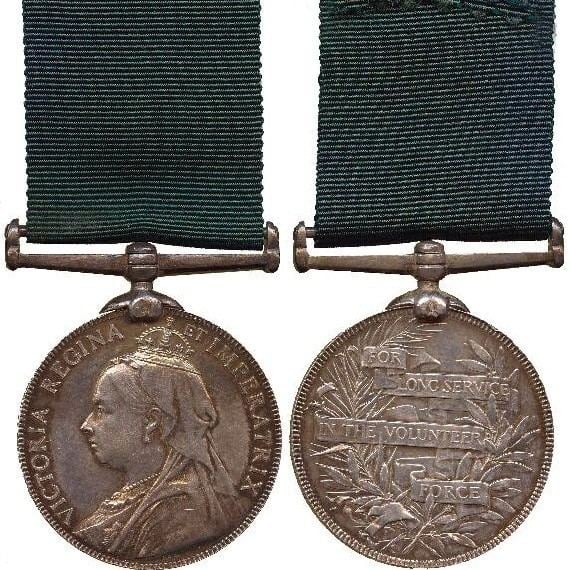Established 1896 | Status Discontinued in 1930 | |
 | ||
Type Military long service medal Eligibility Other ranks and Officers who have served in the ranks of the Volunteer Forces throughout the British Empire Awarded for Twenty years serviceEighteen years service in India | ||
The Volunteer Long Service Medal was instituted in 1894 as an award for long service by other ranks and some officers of the United Kingdom's Volunteer Force. In 1896, the grant of the medal was extended to other ranks and officers who had served in the ranks of the Volunteer Forces throughout the British Empire. A separate new medal was instituted, the Volunteer Long Service Medal for India and the Colonies. Awarding of this medal was discontinued in stages when it was superseded in most territories by the Colonial Auxiliary Forces Long Service Medal in 1899 and in the remainder by the Efficiency Medal in 1930.
Contents
Origin
The Volunteer Long Service Medal was instituted in 1894 as an award for long service by other ranks in the part-time Volunteer Force of the United Kingdom, as well as to officers who had served in the ranks but who had not qualified for the award of the Volunteer Officers' Decoration. The qualifying period of service was twenty years.
Institution
On 13 June 1896, the grant of the Volunteer Long Service Medal was extended by Queen Victoria to members of Volunteer Forces throughout the British Empire, defined as being India, the Dominion of Canada, the Crown Colonies and the British Protectorates. A separate new medal was instituted, the Volunteer Long Service Medal for India and the Colonies. Institution of this medal was not, as usual, by Royal Warrant, but in terms of a special Army Order. This medal was similar in design to the Volunteer Long Service Medal, but bore different inscriptions on the obverse of each monarch's version.
Award criteria
The qualifying period of service was also twenty years, except in India, where it was eighteen years. The medal could be awarded upon the recommendation by an individual's present or, if retired, former commanding officer. Service had to have been consecutive, with allowance being made for special circumstances. Officer recipients had to surrender the medal if they were subsequently awarded either the Volunteer Officers' Decoration or the Volunteer Officers' Decoration for India and the Colonies.
Order of wear
In the order of wear prescribed by the British Central Chancery of the Orders of Knighthood, the Volunteer Long Service Medal for India and the Colonies takes precedence after the Volunteer Officers' Decoration for India and the Colonies and before the Colonial Auxiliary Forces Officers' Decoration.
Description
The medal was struck in silver and is a disk, 1.45 inches (37 millimetres) in diameter, with a raised rim on each side. It is suspended from a straight swivelling silver bar, affixed to the medal by means of a claw and a pin through the upper edge of the medal.
The obverse of the medal depicts the reigning monarch. Three obverse versions of the medal were struck.
The reverse shows a palm and laurel wreath which supports a scrolled banner, bearing the inscription "FOR LONG SERVICE IN THE VOLUNTEER FORCE" in four lines.
The ribbon is the same as that of the Volunteer Long Service Medal, plain dark green and 1 1⁄4 inches (32 millimetres) wide.
Discontinuation
Between 1899 and 1902, the medal was superseded by the Colonial Auxiliary Forces Long Service Medal in the Dominion, the Crown Colonies, the British Protectorates and most Crown Dependencies.
It continued to be awarded to the Isle of Man Volunteers until the 7th (Isle of Man) Volunteer Battalion was disbanded on 3 March 1920, and in Bermuda and India until 1930, when it was finally superseded by the Efficiency Medal.
